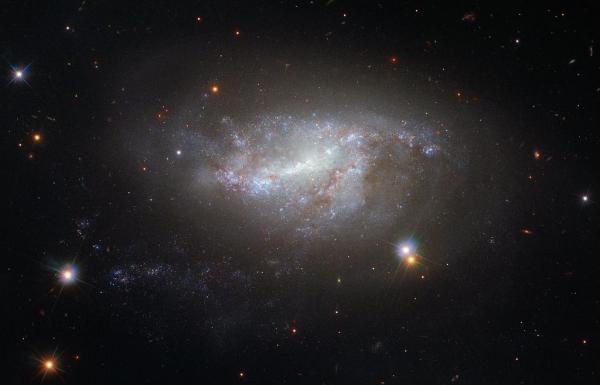BY LETTER
Alien Civilisations Outside the Terragen Sphere
Using advanced telescopes and other detection methods, the visible universe outside the Terragen Sphere can be examined for signs of life, and for signs of intelligent activity. Information from widely-spaced telescopes can be correlated across thousands of light-years using the Wormhole Nexus, allowing a three-dimensional picture of the Hubble Volume to be created.
The more distant an object is, the fewer photons (and other particles) are received by Terragen instruments; so these instruments need to be constructed on a very large scale to collect as much data as possible. Large megastructures such as Dyson Swarms and Banks Orbitals can incorporate arrays of telescopic sensors on the outermost surface of their structure; although these sensors are often used primarily for defence, they can also contribute useful data to the study of the rest of the visible universe and to the search for non-terragen intelligence.
The largest network of telescopic detectors used for this purpose is the Argus Array, a coordinated system more than a thousand light-years across; but many other megascale detector systems exist, and data from such sources is becoming increasingly available thanks to a number of mutual data-sharing agreements between the Sephirotic Empires and other factions. Some data has also been obtained from local xenosophont civilisations such as the Muuh and the Soft Ones, who have been observing the Visible Universe for millions of years.
Looking into the Past
Any location that is far away from the detection system is separated by a gulf of both space and time. Civilisations that are located in the Andromeda Galaxy can only be observed using emissions that have been travelling for two million years; even emissions from locations on the far side of our own galaxy originated long before the Terragen Civilisation emerged.For this reason all information from these locations is necessarily out of date- these civilisations may have already become extinct, like so many in the past history of our own galaxy; indeed any life-bearing world which can be detected may already have become victim to a sterilising event such as a gamma-ray burster, or simply become uninhabitable due to environmental changes. Although the observation of distant xenosophonts is instructive and allows many useful comparisons to be made, there is little guarantee that any contact will ever be made with these civilisations.
 Image from Steve Bowers | |
| Cliotelescopes such as the Coronese Historical Telescope Array can be used to observe the past history of the universe outside the Terragen Sphere, as well as historical events closer to home | |
Articles
- Andromeda Galaxy - Text by Steve Bowers
Also known as M31 and NGC 224, this giant spiral galaxy is the closest major galaxy to the Milky Way. Both belong to the Local Group. Several relativistic craft, including linelayers with wormholes, have left towards the galaxy through history, although the chances that they will reach it intact are probably remote. - Artificially Optimised Galaxies - Text by The Astronomer
Galaxies optimised for habitation by unknown xenosophonts. - Asoka's Pillar - Text by ProxCenBound
An alien Dyson cylinder outside the galaxy, sending strange signals. - Asteroid Digger Civilisation - Text by Rakuen07
Xenosophont civilisation in M33 - Beacon Project, The - Text by Todd Drashner
An attempt to contact extragalactic intelligence. - Black-Hole Brains of NGC 4651 - Text by Steve Bowers
A civilisation in the Virgo Group of galaxies that lives in close association with black holes. - Cormoran SMBH Civilisation, The - Text by Steve Bowers
Alien Civilisation 209 million light years from Sol. - Daidarabotchi Megadyson, The - Text by NexusEye
An artificial hyperobject in a distant galaxy - Deep Traveler, The - Text by Todd Drashner
Mobile Dyson shell recently discovered by IR astronomy in intergalactic space approximately 23 million ly away. - Empire of Screaming Skulls, The - Text by Steve Bowers
A distant xenosophont civilisation observed only by telescope. - Golden Tower Builders, The - Text by M. Alan Kazlev
Extragalactic alien civilization known to have built planetary megastructures. - Leo Hyperobject 1 - Text by Steve Bowers
Vast megastructure 339 million light years from the Milky Way, in Abell 1367 - Search For Non-Terragen Intelligence - Text by Steve Bowers, additions by Stephen Inniss
A large number of xenosophont civilizations have been detected by their emissions but have not been contacted due to light-speed lags. Some seem to be comparable to the Terragen Sphere in extent. - Sextans Swarmers - Text by M. Alan Kazlev
Nanecology / nanoswarm detected across much of the NGC 3169 galaxy and some of NGC 3166. Its origin and toposophic nature is unknown. - Silent Planetarium - Text by The Astronomer
A modosophont-accessible cybercosm depicting the universe beyond the Terragen sphere - Sundrivers - Text by Todd Drashner
Alien civilization discovered in the Virgo cluster approximately 60 million ly from the Milky Way. The seem to be involved in a megascale project that involves the movement of entire stars. - Trader, The - Text by Radtech497
A mysterious xenosophont ship making its way along a circular trajectory that has brought it into the heart of the Soft Ones Volume. - Triangulum Transmission - Text by Todd Drashner
A complex message from another galaxy, giving details of several alien races. - Xenosophont Civilisations in the Laniakea Supercluster - Text by ProxCenBound and The Astronomer
Notable alien civilisations in the local galactic supercluster.
Related Topics
Development Notes
Text by Steve Bowers
Initially published on 01 January 2007.
Initially published on 01 January 2007.
Additional Information
NGC 5197 image by ESA/Hubble, Creative Commons Attribution 4.0 Unported license (more details)







